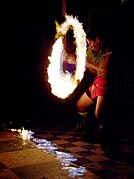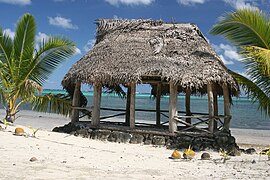Samoa
Independent State of Samoa Malo Saʻoloto Tutoʻatasi o Sāmoa | |
|---|---|
| Motto:Faʻavae i leAtuaSāmoa "Samoa is founded on God" | |
| Anthem:O Le Fuʻa o le Saʻolotoga o Sāmoa "The Banner of Freedom" | |
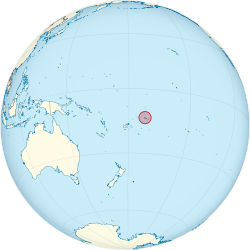 Location of Samoa | |
 Map of Samoa | |
| Capital and largest city | Apia 13°50′00″S171°45′44″W/ 13.83333°S 171.76222°W |
| Official languages | Samoan,English |
| Ethnic groups (2021) |
|
| Religion (2021) |
|
| Demonym(s) | Samoan |
| Government | Unitary parliamentary republic |
| Tuimalealiʻifano Vaʻaletoʻa Sualauvi II | |
| Fiamē Naomi Mataʻafa | |
| Papali’i Li’o Taeu Masipau | |
| Legislature | Legislative Assembly |
| Independence fromNew Zealand | |
| 14 June 1889 | |
| 16 February 1900 | |
| 1 March 1900 | |
| 30 August 1914 | |
• League mandate | 17 December 1920 |
• UN trusteeship | 13 December 1946 |
• Western Samoa Act 1961 | 1 January 1962 |
| 15 December 1976 | |
• Name change from Western Samoa to Samoa | 4 July 1997 |
| Area | |
• Total | 2,831[4]km2(1,093 sq mi) (167th) |
• Water (%) | 0.3 |
| Population | |
• November 2021 census | 205,557[3](176th) |
• Density | 70/km2(181.3/sq mi) |
| GDP(PPP) | 2018 estimate |
• Total | $1.188 billion[5] |
• Per capita | $5,962[5] |
| GDP(nominal) | 2018 estimate |
• Total | $881 million[5] |
• Per capita | $4,420[5] |
| Gini(2013) | medium |
| HDI(2022) | high(116th) |
| Currency | Tālā(WS$[b]) (WST) |
| Time zone | UTC+13[c](WST) |
| Date format | dd/mm/yyyy |
| Driving side | left[d] |
| Calling code | +685 |
| ISO 3166 code | WS |
| Internet TLD | .ws |
| |
Samoa,[note 1]officially theIndependent State of Samoa[note 2]and until 1997 known asWestern Samoa(Samoan:Sāmoa i Sisifo), is aPolynesianisland countryconsisting of two main islands (Savai'iandUpolu); two smaller, inhabited islands (ManonoandApolima); and several smaller, uninhabited islands, including theAleipata Islands(Nu'utele,Nu'ulua,FanuatapuandNamua). Samoa is located 64 km (40 mi) west ofAmerican Samoa,889 km (552 mi) northeast ofTonga,1,152 km (716 mi) northeast ofFiji,483 km (300 mi) east ofWallis and Futuna,1,151 km (715 mi) southeast ofTuvalu,519 km (322 mi) south ofTokelau,4,190 km (2,600 mi) southwest ofHawaii,and 610 km (380 mi) northwest ofNiue.The capital and largest city isApia.TheLapitapeople discovered and settled theSamoan Islandsaround 3,500 years ago. They developed aSamoan languageandSamoan cultural identity.
Samoa is aunitaryparliamentary democracywith 11administrative divisions.It is asovereign stateand a member of theCommonwealth of Nations.Western Samoa was admitted to theUnited Nationson 15 December 1976.[14]Because of the Samoans' seafaring skills, pre-20th-century European explorers referred to the entireisland group,including American Samoa, as the "Navigator Islands".[15][16]The country was a colony of theGerman Empirefrom 1899 to 1915, then came under a joint British and New Zealand colonial administration until 1 January 1962, when it became independent.
History
[edit]Early history
[edit]Samoa was discovered and settled by theLapita people(Austronesian people who spokeOceanic languages), who travelled fromIsland Melanesia.The earliest human remains found in Samoa are dated to between roughly 2,900 and 3,500 years ago. The remains were discovered at a Lapita site atMulifanua,and the scientists' findings were published in 1974.[17]The Samoans' origins have been studied in modern times through scientific research on Polynesiangenetics,linguistics,andanthropology.Although this research is ongoing, a number of theories have been proposed. One theory is that the original Samoans wereAustronesianswho arrived during a final period of eastward expansion of the Lapita peoples out of Southeast Asia andMelanesiabetween 2,500 and 1,500 BCE.[18]
Intimate sociocultural and genetic ties were maintained between Samoa, Fiji, and Tonga, and the archaeological record supports oral tradition and native genealogies that indicate interisland voyaging and intermarriage among precolonial Samoans,Fi gian s,andTongans.Notable figures in Samoan history included theTui Manu'aline, QueenSalamasina,King Fonotiand the fourtama-a-aiga:Malietoa,Tupua Tamasese,Mata'afa,andTuimalealiifano.Nafanuawas a famous woman warrior who was deified in ancient Samoan religion and whose patronage was highly sought after by successive Samoan rulers.[19]
Today, all of Samoa is united under its two principal royal families: the Sā Malietoa of the ancient Malietoa lineage that defeated the Tongans in the 13th century; and the Sā Tupua, Queen Salamasina's descendants and heirs who ruled Samoa in the centuries that followed her reign. Within these two principal lineages are the four highest titles of Samoa - the elder titles of Malietoa and Tupua Tamasese of antiquity and the newer Mata'afa and Tuimalealiifano titles, which rose to prominence in 19th-century wars that preceded the colonial period.[19]These four titles form the apex of the Samoan matai system as it stands today.
Contact with Europeans began in the early 18th century.Jacob Roggeveen,a Dutchman, was the first known non-Polynesian to sight the Samoan islands in 1722. This visit was followed by French explorerLouis-Antoine de Bougainville,who named them the Navigator Islands in 1768. Contact was limited before the 1830s, which is when Englishmissionariesof the London Missionary Society, whalers, and traders began arriving.[20]
19th century
[edit]Visits by American trading andwhalingvessels were important in the early economic development of Samoa. TheSalembrigRoscoe(Captain Benjamin Vanderford), in October 1821, was the first American trading vessel known to have called, and theMaro(Captain Richard Macy) ofNantucket,in 1824, was the first recorded United States whaler at Samoa.[21]The whalers came for fresh drinking water, firewood, provisions and, later, for recruiting local men to serve as crewmen on their ships. The last recorded whaler visitor was theGovernor Mortonin 1870.[22]
Christian missionary work in Samoa began in 1830 whenJohn Williamsof theLondon Missionary Societyarrived inSapapali'ifrom theCook IslandsandTahiti.[23]According to Barbara A. West, "The Samoans were also known to engage in 'headhunting', a ritual of war in which a warrior took the head of his slain opponent to give to his leader, thus proving his bravery."[24]
InA Footnote to History: Eight Years of Trouble in Samoa(1892),Robert Louis Stevensondetails the activities of thegreat powersbattling for influence in Samoa – the United States, Germany and Britain – and the political machinations of the various Samoan factions within their indigenous political system.[25][26]Even as they descended into ever greater interclan warfare, what most alarmed Stevenson was the Samoans' economic innocence. In 1894, just months before his death, he addressed the island chiefs:
There is but one way to defend Samoa. Hear it before it is too late. It is to make roads, and gardens, and care for your trees, and sell their produce wisely, and, in one word, to occupy and use your country... if you do not occupy and use your country, others will. It will not continue to be yours or your children's, if you occupy it for nothing. You and your children will in that case be cast out into outer darkness.
He had "seen these judgments of God" inHawaii,where abandoned native churches stood like tombstones "over a grave, in the midst of the white men's sugar fields".[27]
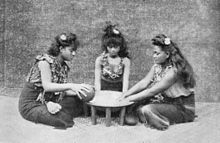
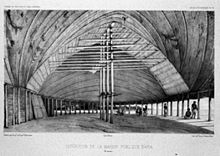

The Germans, in particular, began to show great commercial interest in theSamoan Islands,especially on the island of Upolu, where German firms monopolisedcopraandcocoa beanprocessing. The United States laid its own claim, based on commercial shipping interests in Pearl Harbor inHawaiiand Pago Pago Bay in eastern Samoa, and forced alliances, most conspicuously on the islands ofTutuilaandManu'a,which becameAmerican Samoa.
Britain also sent troops to protect British business enterprise, harbour rights, and consulate office. This was followed by aneight-year civil war,during which each of the three powers supplied arms, training and in some cases combat troops to the warring Samoan parties. TheSamoan crisiscame to a critical juncture in March 1889 when all three colonial contenders sent warships into Apia harbour, and a larger-scale war seemed imminent. A massive storm on 15 March 1889 damaged or destroyed the warships, ending the military conflict.[28]
TheSecond Samoan Civil Warreached a head in 1898 whenGermany,theUnited Kingdom,and the United States were locked in dispute over who should control the Samoan Islands. TheSiege of Apiaoccurred in March 1899. Samoan forces loyal to PrinceTanuwere besieged by a larger force of Samoan rebels loyal toMata'afa Iosefo.Supporting Prince Tanu were landing parties from four British and American warships. After several days of fighting, the Samoan rebels were finally defeated.[29]
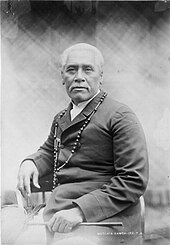


American and British warships shelled Apia on 15 March 1899, including theUSSPhiladelphia.Germany, the United Kingdom and the United States quickly resolved to end the hostilities and divided the island chain at theTripartite Convention of 1899,signed at Washington on 2 December 1899 with ratifications exchanged on 16 February 1900.[30][31]
The eastern island-group became a territory of the United States (the Tutuila Islands in 1900 and officially Manu'a in 1904) and was known as American Samoa. The western islands, by far the greater landmass, becameGerman Samoa.The United Kingdom had vacated all claims in Samoa and in return received (1) termination of German rights inTonga,(2) all of the Solomon Islands south of Bougainville, and (3) territorial alignments in West Africa.[32]
German Samoa (1900–1914)
[edit]
TheGerman Empiregoverned the western part of the Samoan archipelago from 1900 to 1914.Wilhelm Solfwas appointed the colony's first governor. In 1908, when the non-violentMau a Puleresistance movement arose, Solf did not hesitate to banish the Mau leaderLauaki Namulau'ulu Mamoeto Saipan in the GermanNorthern Mariana Islands.[33]
The German colonial administration governed on the principle that "there was only one government in the islands."[34]Thus, there was no SamoanTupu(king), nor analii sili(similar to a governor), but twoFautua(advisors) were appointed by the colonial government.TumuaandPule(traditional governments of Upolu and Savai'i) were for a time silent; all decisions on matters affecting lands and titles were under the control of the colonial Governor.
In the first month ofWorld War I,on 29 August 1914, troops of the New Zealand Expeditionary Force landed unopposed on Upolu andseized controlfrom the German authorities, following a request by Great Britain for New Zealand to perform this "great and urgent imperial service."[35]
New Zealand rule (1914–1961)
[edit]From the end ofWorld War Iuntil 1962, New Zealand controlled Western Samoa as aClass C Mandateundertrusteeshipthrough theLeague of Nations,[31][36]then through the United Nations. Between 1919 and 1962, Samoa was administered by theDepartment of External Affairs,a government department which had been specially created to oversee New Zealand's Island Territories and Samoa.[37]In 1943, this department was renamed theDepartment of Island Territoriesafter a separateDepartment of External Affairswas created to conduct New Zealand's foreign affairs.[38]During the period of New Zealand control, their administrators were responsible for two major incidents.
Flu pandemic
[edit]In the first incident, approximately one fifth of the Samoan population died in theinfluenza epidemic of 1918–1919.[39][31]
In 1918, during the final stages ofWorld War I,theSpanish fluhad taken its toll, spreading rapidly from country to country. On Samoa, there had been no epidemic of pneumonic influenza in Western Samoa before the arrival of theSSTalunefromAucklandon 7 November 1918. The NZ administration allowed the ship to berth in breach of quarantine; within seven days of this ship's arrival, influenza became epidemic in Upolu and then spread rapidly throughout the rest of the territory.[40]Samoa suffered the most of all Pacific islands, with 90% of the population infected; 30% of adult men, 22% of adult women and 10% of children died.[41]The cause of the epidemic was confirmed in 1919 by aRoyal Commissionof Inquiry into the Epidemic concluded that there had been no epidemic of pneumonic influenza in Western Samoa before the arrival of theTalunefrom Auckland on 7 November 1918.[40]
The pandemic undermined Samoan confidence in New Zealand's administrative capacity and competence.[31]Some Samoans asked that the rule of the islands be transferred to the Americans or the British.[31]
Mau movement
[edit]The second major incident arose out of an initially peaceful protest by theMau(which literally translates as "strongly held opinion" ), a non-violent popular pro-independence movement which had its beginnings in the early 1900s on Savai'i, led byLauaki Namulauulu Mamoe,an orator chief deposed by Solf. In 1909, Lauaki was exiled toSaipanand died en route back to Samoa in 1915.
By 1918, Western Samoa had a population of some 38,000 Samoans and 1,500 Europeans.[42]
However, native Samoans greatly resented New Zealand's colonial rule, and blamed inflation and the catastrophic 1918 flu epidemic on its misrule.[43]By the late 1920s the resistance movement against colonial rule had gathered widespread support. One of the Mau leaders wasOlaf Frederick Nelson,a half Samoan and half Swedish merchant.[44]Nelson was eventuallyexiledduring the late 1920s and early 1930s, but he continued to assist the organisation financially and politically. In accordance with the Mau's non-violent philosophy, the newly elected leader, High Chief Tupua Tamasese Lealofi, led his fellow uniformed Mau in a peaceful demonstration in downtown Apia on 28 December 1929.[45]
The New Zealand police attempted to arrest one of the leaders in the demonstration. When he resisted, a struggle developed between the police and the Mau. The officers began to fire randomly into the crowd and used aLewis machine gun,mounted in preparation for the demonstration, to disperse the demonstrators.[46]Mau leader and paramount chiefTupua Tamasese Lealofi IIIwas shot from behind and killed while trying to bring calm and order to the Mau demonstrators. Ten others died that day and approximately 50 were injured by gunshot wounds and police batons.[47]That day would come to be known in Samoa as Black Saturday.
On 13 January 1930, the New Zealand authorities banned the organisation. As many as 1500 Mau men took to the bush, pursued by an armed force of 150 marines and seamen from thelight cruiserHMSDunedin,and 50 military police. They were supported by a seaplane flown by Flight LieutenantSidney Wallingfordof theNew Zealand Permanent Air Force.Villages were raided, often at night and with fixed bayonets. In March, through the mediation of local Europeans and missionaries, Mau leaders met New Zealand's Minister of Defence and agreed to disperse.[48]
Supporters of the Mau continued to be arrested, so women came to the fore rallying supporters and staging demonstrations. The political stalemate was broken following the victory of the Labour Party in New Zealand's 1935 general election. A 'goodwill mission' to Apia in June 1936 recognised the Mau as a legitimate political organisation, and Olaf Nelson was allowed to return from exile.[48]In September 1936, Samoans exercised for the first time the right to elect the members of the advisoryFono of Faipule,[49]with representatives of theMau movementwinning 31 of the 39 seats.[50]
Independence
[edit]After repeated efforts by the Samoan independence movement, the New Zealand Western Samoa Act of 24 November 1961 terminated the Trusteeship Agreement and granted the country independence as theIndependent State of Western Samoa,effective 1 January 1962.[51][52]Western Samoa, the first small-island country in the Pacific to become independent, signed aTreaty of Friendshipwith New Zealand later in 1962. Western Samoa joined theCommonwealth of Nationson 28 August 1970. While independence was achieved at the beginning of January, Samoa annually celebrates 1 June as its independence day.[53][54]
On 15 December 1976, Western Samoa was admitted to theUnited Nationsas the 147thmember state.It asked to be referred to in the United Nations as theIndependent State of Samoa.[55]
Travel writerPaul Therouxnoted marked differences between the societies in Western Samoa andAmerican Samoain 1992.[56]
On 4 July 1997 the government amended the constitution to change the name of the country fromWestern SamoatoSamoa,[57]the name it had been called by in the United Nations since it joined.[58]American Samoaprotested against the name change, asserting that it diminished its own identity.[58]
In 2002, New Zealand prime ministerHelen Clarkformally apologised for New Zealand's role in the Spanish influenza outbreak in 1918 that killed over a quarter of Samoa's population and for the Black Saturday killings in 1929.[59][60]
On 7 September 2009, the government changed the rule of the road fromright to left,in common with most other Commonwealth countries - most notably countries in the region such as Australia and New Zealand, home to large numbers of Samoans.[61]This made Samoa the first country in the 21st century to switch to driving on the left.[62]
At the end of December 2011, Samoa changed its time zone offset from UTC−11 to UTC+13, effectively jumping forward by one day, omitting Friday, 30 December from the local calendar. This also had the effect of changing the shape of theInternational Date Line,moving it to the east of the territory.[63]This change aimed to help the nation boost its economy in doing business with Australia and New Zealand. Before this change, Samoa was 21 hours behindSydney,but the change means it is now three hours ahead. The previous time zone, implemented on 4 July 1892, operated in line with American traders based inCalifornia.[64]In October 2021, Samoa ceaseddaylight saving time.[65]
In 2017, Samoa signed the UNtreaty on the Prohibition of Nuclear Weapons.[66]
In June 2017, Parliament amended Article 1 of the Samoan Constitution to makeChristianitythe state religion.[2][67]
In September 2019, ameasles outbreakresulted in the deaths of 83 people. Following the outbreak, the government imposed a curfew in December later during the same year.
In May 2021,Fiamē Naomi Mataʻafabecame Samoa's first female prime minister. Mataʻafa'sFASTparty narrowly won theelection,ending the rule of long-term Prime MinisterTuilaʻepa Saʻilele Malielegaoiof theHuman Rights Protection Party(HRPP),[68]although theconstitutional crisiscomplicated and delayed this. On 24 May 2021, she was sworn in as the new prime minister, though it was not until July that the Supreme Court ruled that her swearing-in was legal, thus ending the constitutional crisis and bringing an end to Tuilaʻepa's 22-year premiership. The FAST party's success in the 2021 election and subsequent court rulings also ended nearly four decades of HRPP rule.[69]
Government and politics
[edit]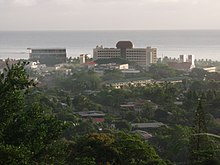
The1960 constitution,which formally came into force with independence from New Zealand in 1962, builds on the British pattern ofparliamentary democracy,modified to take account of Samoan customs.[70]The national modern Government of Samoa is referred to as theMalo.
Fiamē Mataʻafa Faumuina Mulinuʻu II,one of the four highest-rankingparamount chiefsin the country, became Samoa's firstPrime Minister.Two other paramount chiefs at the time of independence were appointed jointheads of state(O Ao o le Malo) for life.Tupua Tamasese Meaʻoledied in 1963, leavingMalietoa Tanumafili IIsole head of state until his death on 11 May 2007. The next head of state wasTui Atua Tupua Tamasese Efi,who was elected by the legislature on 17 June 2007 for a fixed five-year term,[71]and was re-elected unopposed in July 2012. He was succeeded byTuimalealiʻifano Vaʻaletoʻa Sualauvi IIin 2017. Tuimalealiʻifano was reappointed for a second term of five years in 2022.[72]
The unicameral legislature (theFono) consists of 51 members serving 5-year terms. Forty-nine aremataititle-holders elected from territorial districts by Samoans; the other two are chosen by non-Samoans with no chiefly affiliation on separate electoral rolls. At least, 10% of the MPs are women.[73]Universal suffrage was adopted in 1990, but only chiefs (matai) may stand for election to the Samoan seats. There are more than 25,000 matais in the country, about 5% of whom are women.[74]The prime minister, chosen by a majority in the Fono, is appointed by the head of state to form a government. The prime minister's choices for the 12cabinet positionsare appointed by the head of state, subject to the continuing confidence of the Fono.
Prominent women in Samoan politics include the lateLaulu Fetauimalemau Mata'afa(1928–2007) fromLotofagaconstituency, the wife of Samoa's first prime minister. Their daughterFiamē Naomi Mataʻafais a high chief and a long-serving senior member of cabinet, who was elected Prime Minister in 2021. Other women in politics include Samoan scholar and eminent professorAiono Fanaafi Le Tagaloa,orator-chiefMatatumua MaimoanaandSafuneitu'uga Pa'aga Neri(as of 2016[update]the Minister of Communication and Technology).
The judicial system incorporatesEnglish common lawand local customs. TheSupreme Court of Samoais the court of highest jurisdiction. TheChief Justice of Samoais appointed by the head of state upon the recommendation of the prime minister.
Administrative divisions
[edit]Samoa comprises elevenitūmālō(political districts). These are the traditional eleven districts which predate European arrival. Each district has its own constitutional foundation (fa'avae) based on the traditional order of title precedence found in each district'sfaalupega(traditional salutations).[75]The capital village of each district administers and coordinates the affairs of the district and confers each district's paramount title, amongst other responsibilities.
For example:
A'anahas its capital atLeulumoega.The paramountTama-a-'Aiga(royal lineage) title of A'ana isTuimalealiifano.The paramountpāpātitle of A'ana is theTui A'ana.The orator group which confers this title — theFaleiva(House of Nine) — is based at Leulumoega.
Ātuahas its capital atLufilufi.The paramountTama-a-'Aiga(royal lineage) titles of Ātua are Tupua Tamasese (based inFalefaand Salani) and Mata'afa (based in Amaile and Lotofaga). The two main political families who confer the respective titles are'Aiga Sā Fenunuivaoand 'Aiga Sā Levālasi.The paramountpāpātitle of Ātua is theTui Ātua.The orator group which confers this title — theFaleono(House of Six) — is based at Lufilufi.
Tuamasagahas its capital atAfega.The paramounttama-a-'Aiga(royal lineage) title of Tuamasaga is theMalietoatitle, based inMalie.The main political family that confers the Malietoa title is 'Aiga Sā Malietoa, with Auimatagi as the main speaker for the family. The paramountpāpātitles of Tuamasaga are Gatoaitele (conferred by Afega) and Vaetamasoalii (conferred by Safata).[26]
The elevenitūmālōare identified to be:
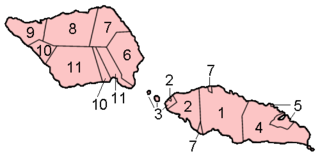
OnUpolu
- 1.Tuamasaga(Afega)1
- 2.A'ana(Leulumoega)
- 3.Aiga-i-le-Tai(Mulifanua)2
- 4.Atua(Lufilufi)3
- 5.Va'a-o-Fonoti(Samamea)
OnSavai'i
- 6.Fa'asaleleaga(Safotulafai)
- 7.Gaga'emauga(Saleaula)4
- 8.Gaga'ifomauga(Safotu)
- 9.Vaisigano(Asau)
- 10.Satupa'itea(Satupa'itea)
- 11.Palauli(Vailoa)
1including the faipule district ofSiumu
2including islandsManono,ApolimaandNu'ulopa
3including theAleipata IslandsandNu'usafe'eIsland
4smaller parts also onUpolu(Salamumu, incl. Salamumu-Uta and Leauvaa villages)
Human rights
[edit]Major areas of concern include the under-representation of women, domestic violence and poor prison conditions.Homosexual actsare illegal in Samoa.[76]
State religion
[edit]In June 2017, an Act was passed changing the country's constitution to include a reference to theTrinity.As amended, Article 1 of the Samoan Constitution states that "Samoa is a Christian nation founded on God the Father, the Son and the Holy Spirit".[77]According toThe Diplomat,"What Samoa has done is shift references to Christianity into the body of the constitution, giving the text far more potential to be used in legal processes."[78]The preamble to the constitution already described the country as "an independent State based on Christian principles and Samoan custom and traditions."[78]
Military and police
[edit]Samoa has no formal defence structure or regular armed forces.It has informal defence ties withNew Zealand,which is required to consider any request for assistance from Samoa under the bilateralTreaty of Friendshipof 1962.[79]
Officers of the national police force, theSamoa Police Service,are regularly unarmed, but may be armed in exceptional circumstances with ministerial approval.[80]As of 2022 there are between 900 and 1,100 police officers in Samoa.
Geography
[edit]


Samoa lies south of the equator, about halfway between Hawaii and New Zealand, in thePolynesianregion of the Pacific Ocean. The total land area is 2,842 km2(1,097 sq mi),[81]consisting of the two large islands ofUpoluandSavai'i(which together account for 99% of the total land area) and eight small islets.
The islets are:[82]
- the three islets in theApolima Strait(Manono Island,ApolimaandNu'ulopa)
- the fourAleipata Islandsoff the eastern end of Upolu (Nu'utele,Nu'ulua,Namua,andFanuatapu)
- Nu'usafe'e,which is less than1 ha (2+1⁄2acres) in area and lies about 1.4 km (0.87 mi) off the south coast of Upolu at the village ofVaovai
The main island of Upolu is home to nearly three-quarters of Samoa's population, and to the capital city,Apia.
The Samoan islands result geologically fromvolcanism,originating with theSamoa hotspot,which probably results from amantle plume.[83][84]While all of the islands have volcanic origins, only Savai'i, the westernmost island in Samoa, remains volcanically active, with the most recent eruptions atMt Matavanu(1905–1911),Mata o le Afi(1902) andMauga Afi(1725). The highest point in Samoa isMt Silisili,at 1,858 m (6,096 ft). TheSaleaulalava fields situated on the central north coast of Savai'i result from the Mt Matavanu eruptions, which left 50 km2(19 sq mi) of solidified lava.[85]
Savai'i is the largest of the Samoan islands and the sixth-largest Polynesian island (after New Zealand'sNorth,SouthandStewart Islandsand the Hawaiian islands ofHawaiʻiandMaui). The population of Savai'i is 42,000 people.
Climate
[edit]Samoa has an equatorial climate, with an average annual temperature of 26.5 °C (79.7 °F) and a main rainy season from November to April, although heavy rain may fall in any month.[86]
| Climate data for Apia | |||||||||||||
|---|---|---|---|---|---|---|---|---|---|---|---|---|---|
| Month | Jan | Feb | Mar | Apr | May | Jun | Jul | Aug | Sep | Oct | Nov | Dec | Year |
| Mean daily maximum °C (°F) | 30.4 (86.7) |
30.6 (87.1) |
30.6 (87.1) |
30.7 (87.3) |
30.4 (86.7) |
30.0 (86.0) |
29.5 (85.1) |
29.6 (85.3) |
29.9 (85.8) |
30.1 (86.2) |
30.3 (86.5) |
30.5 (86.9) |
30.2 (86.4) |
| Mean daily minimum °C (°F) | 23.9 (75.0) |
24.2 (75.6) |
24.0 (75.2) |
23.8 (74.8) |
23.4 (74.1) |
23.2 (73.8) |
22.6 (72.7) |
22.8 (73.0) |
23.1 (73.6) |
23.4 (74.1) |
23.6 (74.5) |
23.8 (74.8) |
23.5 (74.3) |
| Average rainfall mm (inches) | 489.0 (19.25) |
368.0 (14.49) |
352.1 (13.86) |
211.2 (8.31) |
192.6 (7.58) |
120.8 (4.76) |
120.7 (4.75) |
113.2 (4.46) |
153.9 (6.06) |
224.3 (8.83) |
261.7 (10.30) |
357.5 (14.07) |
2,965 (116.72) |
| Source:World Meteorological Organization(UN)[87] | |||||||||||||
Ecology
[edit]Samoa forms part of theSamoan tropical moist forestsecoregion.[88]Since human habitation began, about 80% of the lowland rainforests have disappeared. Within the ecoregion about 28% of plants and 84% of land birds are endemic.[89]
Economy
[edit]


TheUnited Nationshas classified Samoa as aneconomically developing countrysince 2014.[90]As of 2017[update]Samoa's gross domestic product inpurchasing-power paritywas estimated at $1.13 billionU.S. dollars,ranking the country 204th in the world. Theservices sectoraccounted for 66% of GDP, followed byindustryandagricultureat 23.6% and 10.4% respectively.[91]For the same year, the Samoanlabour forcewas estimated at 50,700.[91]
TheCentral Bank of Samoaissues and regulates Samoa's currency, theSamoan tālā.[92] The economy of Samoa has traditionally depended on agriculture and fishing at the local level. In modern times,development aid,private familyremittances from overseas,and agricultural exports have become key factors in the nation's economy. Agriculture employs two-thirds of the labour force and furnishes 90% of exports, featuringcoconutcream,coconut oil,noni(juice of thenonufruit, as it is known in Samoan), andcopra.[1]
Sixty percent of Samoa's electricity comes from renewablehydro,solar, and wind sources, with the remainder produced by diesel generators. The Electric Power Corporation set a goal of100% renewable energyby 2021.[93]
Agriculture
[edit]In the period before German colonisation (from the late 19th century), Samoa produced mostly copra. German merchants and settlers were active in introducing large-scaleplantationoperations and in developing new industries, notably cocoa beans and rubber, relying on imported labourers fromChinaandMelanesia.When the value ofnatural rubberfell drastically, about the end of the Great War (World War I) in 1918, the New Zealand government encouraged the production of bananas, for which there is a large market inNew Zealand.[94]
Because of variations in altitude, Samoa can cultivate a large range of tropical and subtropical crops. Land is not generally available to outside interests. Of the total land area of 2,934 km2(725,000 acres), about 24.4% is in permanent crops and another 21.2% is arable. About 4.4% is Western Samoan Trust Estates Corporation (WSTEC).[95]
The staple products of Samoa are copra (dried coconut meat),cocoa beans(for chocolate), rubber, and bananas.[96]The annual production of both bananas and copra has been[when?]in the range of 13,000–15,000 tonnes (14,000–17,000 tons). If thecoconut rhinoceros beetlein Samoa were eradicated, Samoa could produce in excess of 40,000 tonnes (44,000 tons) of copra. Samoan cocoa beans are of very high quality and are used in fine New Zealand chocolates. Most areCriollo-Forastero hybrids. Coffee grows well, but production has been uneven. WESTEC is the biggest coffee producer.
Other agricultural industries have proven less successful.Sugarcaneproduction was originally established by Germans in the early 20th century. Old train tracks for transporting cane can be seen at some plantations east ofApia.Pineapplesgrow well in Samoa, but have not moved beyond local consumption to become a major export.[97][98]
Demographics
[edit]
Samoa reported a population of 194,320 in its 2016 census.[99]This number increased to 205,557 in its 2021 Census.[3]About three-quarters of the population live on the main island ofUpolu.[70]
Health
[edit]A measles outbreak began in October 2019. By the time the outbreak subsided in early January, the number of deaths reached 83 (0.31 per 1,000, based on a population of 201,316[100]) and over 4,460 cases (2.2% of the population) of measles in Samoa,[101][102]mainly children under four years old, and 10 reported cases inFiji.[103]
Ethnic groups
[edit]The population is 96%Samoans,2% dual Samoan-New Zealanderand 1.9% other, according to a 2011 estimate in theCIA World Factbook.[91]
Languages
[edit]Samoan (Gagana Fa'asāmoa) and English are the official languages. Including second-language speakers, there are more speakers of Samoan than English in Samoa.[104]Samoan Sign Languageis also commonly used among thedeafpopulation of Samoa. To emphasize the importance of full inclusion with sign language, elementary Samoan Sign Language was taught to members of the Samoa Police Service, Red Cross Society, and public during the 2017 International Week of the Deaf.[105]
Religion
[edit]Since 2017, Article 1 of the Samoan Constitution states that "Samoa is a Christian nation founded of God the Father, the Son and the Holy Spirit".[2]
According to the 2021 Census,the distribution of religious groupsare as follows:Christian Congregational Church of Samoa27%,Roman Catholic19%,The Church of Jesus Christ of Latter-day Saints18%,Methodist12%,Assembly of God10%, and the remaining religious groups accounting for 16% of the population.[3]The Head of State until 2007,Malietoa Tanumafili II,was aBaháʼí.Samoa hosts the seventh (of nine current)Baháʼí Houses of Worshipin the world; completed in 1984 and dedicated by the Head of State, it is located in Tiapapata, 8 km (5.0 mi) fromApia.
-
Roman CatholicImmaculate Conceptionof Mary cathedral.
Education
[edit]The Samoan government provides eight years of primary and secondary education that is tuition-free and is compulsory through age 16.[106]
Samoa's main post-secondary educational institution is theNational University of Samoa,established in 1984. The country is also home to several branches of the multi-nationalUniversity of the South Pacificand theOceania University of Medicine.[107]
Education in Samoa has proved to be effective as a 2012UNESCOreport stated that 99 percent of Samoan adults are literate.[108]
The Human Rights Measurement Initiative (HRMI)[109]finds that Samoa is fulfilling only 88.0% of what it should be fulfilling for the right to education based on the country's level of income.[110]HRMI breaks down the right to education by looking at the rights to both primary education and secondary education. While taking into consideration Samoa's income level, the nation is achieving 97.7% of what should be possible based on its resources (income) for primary education but only 78.3% for secondary education.[110]
Culture
[edit]
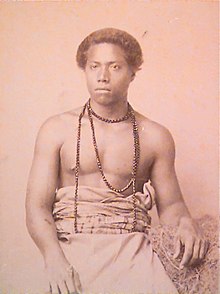
Faʻa Sāmoa,or the traditional Samoan way, remains a strong force in Samoan life and politics. As one of the oldest Polynesian cultures, the fa'a Samoa developed over a period of 3,000 years, withstanding centuries of European influence to maintain its historical customs, social and political systems, andlanguage.Cultural customs such as theSamoa 'ava ceremonyare significant and solemn rituals at important occasions including the bestowal ofmataichiefly titles. Items of great cultural value include the finely woven'ie toga.[111][112]
Samoan mythologyincludes many gods with creation stories and figures of legend such asTagaloaand the goddess of warNafanua,the daughter ofSaveasi'uleo,ruler of the spirit realmPulotu.Other legends include the well known story ofSina and the Eelwhich explains the origins of the first coconut tree.
Some Samoans are spiritual and religious, and have subtly adapted the dominant religion of Christianity to 'fit in' with fa'a Samoa and vice versa. Ancient beliefs continue to co-exist side by side with Christianity, particularly in regard to the traditional customs and rituals of fa'a Samoa. The Samoan culture is centred on the principle of vāfealoa'i, the relationships between people. These relationships are based on respect, or fa'aaloalo. When Christianity was introduced in Samoa, most Samoan people converted. Currently 98% of the population identify themselves as Christian.[113]
Some Samoans live a communal way of life, participating in activities collectively. Examples of this are the traditional Samoanfale(houses) which are open with no walls, using blinds made of coconut palm fronds during the night or bad weather.
The Samoansivadance has unique gentle movements of the body in time to music and tells a story, although the Samoan male dances can be more snappy.[114]Thesasais also a traditional dance where rows of dancers perform rapidsynchronisedmovements in time to the rhythm of wooden drums(pate)or rolled mats. Another dance performed by males is called thefa'ataupatior the slap dance, creating rhythmic sounds by slapping different parts of the body. This is believed to have been derived from slapping insects on the body.[citation needed]
The form and construction of traditionalarchitecture of Samoawas a specialised skill byTufuga fai falethat was also linked to other cultural artforms.
-
A Samoan fire dancer.
Media
[edit]Tattooing
[edit]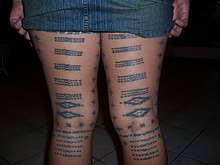
As with other Polynesian cultures (Hawaiian,TahitianandMāori) with significant and unique tattoos, Samoans have two gender specific and culturally significant tattoos. For males, it is called thePe'aand consists of intricate and geometrical patternstattooedthat cover areas from the knees up towards the ribs. A male who possesses such a tatau is called asoga'imiti.A Samoan girl orteineis given amalu,which covers the area from just below her knees to her upper thighs.[115]
Contemporary culture
[edit]Albert Wendtis a significant Samoan writer whose novels and stories tell the Samoan experience. In 1989, his novelFlying Fox in a Freedom Treewas made into a feature film in New Zealand, directed byMartyn Sanderson.[116]Another novelSons for the Return Homehad also been made into a feature film in 1979, directed byPaul Maunder.[117]
The lateJohn Kneubuhl,born in American Samoa, was an accomplished playwright and screenwriter and writer. His playThink of Gardenpremiered in Auckland in 1993 a year after his death, it was directed byNathaniel Lees,is set in 1929 and is about Samoa's struggle for independence.[118][119]
Sia Figielwon the 1997Commonwealth Writers' Prizefor fiction in the south-east Asia/South Pacific region with her novel "Where We Once Belonged".
Momoe Malietoa Von Reicheis an internationally recognised poet and artist.
Tusiata Aviais a performance poet. Her first book of poetryWild Dogs Under My Skirtwas published by Victoria University Press in 2004. Dan Taulapapa McMullinis an artist and writer.
Other Samoan poets and writers includeSapa'u Ruperake Petaia,Eti Sa'agaandSavea Sano Malifa,the editor of theSamoa Observer.
In music, popular local bands includeThe Five Stars,Penina o Tiafau and Punialava'a. The Yandall Sisters' cover of the songSweet Inspirationreached number one on the New Zealand charts in 1974.
King Kapisiwas the first hip hop artist to receive the prestigious New ZealandAPRASilver Scroll Award in 1999 for his songReverse Resistance.The music video forReverse Resistancewas filmed in Savai'i at his villages.
Other successful Samoan hip hop artists include rapperScribe,Dei Hamo,SavageandTha Feelstylewhose music videoSuamaliewas filmed in Samoa.
Lemi Ponifasiois a director and choreographer who is prominent internationally with his dance Company MAU.[120] Neil Ieremia's companyBlack Gracehas also received international acclaim with tours to Europe and New York.
Hip hophas had a significant impact on Samoan culture. According to Katerina Martina Teaiwa, PhD from the University of Hawaii at Manoa, "Hip hop culture in particular is popular amongst Samoan youth."[121]As in many other countries, hip hop music is popular. In addition, the integration of hip hop elements into Samoan tradition also "testifies to the transferability of the dance forms themselves," and to the "circuits through which people and all their embodied knowledge travel."[122]Dance both in its traditional form and its more modern forms has remained a central cultural currency to Samoans, especially youths.[121]
The arts organisationTautai Pacific Arts Trustwas an informal collective of visual artists includingFatu Feu'u,Johnny Penisula,Shigeyuki Kihara,Michel Tuffery,andLily Laitain the 1980s and formalised into a trust in 1995 and is now a leading Pacific arts organisation directed byAanoalii Rowena Fuluifaga.[123][124]Marilyn Kohlhaseran a Pacific focused gallery calledOkaioceanikartfrom 2007 to 2013.[125]Other important Samoan contemporary artists includeAndy Leleisi'uao,andRaymond Sagapolutele.[126][127]
DirectorSima Uraleis a filmmaker. Urale's short filmO Tamaitiwon the prestigious Best Short Film at theVenice Film Festivalin 1996. Her first feature filmApron Stringsopened the 2008NZ International Film Festival.The feature filmSiones Wedding,co-written byOscar Kightley,was financially successful following premieres in Auckland and Apia. The 2011 filmThe Oratorwas the first ever fully Samoan film, shot in Samoa in the Samoan language with a Samoan cast telling a uniquely Samoan story. Written and directed byTusi Tamasese,it received much critical acclaim and attention at film festivals throughout the world.
Sport
[edit]
The main sports played in Samoa arerugby union,Samoan cricketandnetball.Rugby union is the national football code of Samoa. In Samoan villages, volleyball is also popular.
Rugby union is the national sport in Samoa and thenational team,nicknamed the Manu Samoa, is consistently competitive against teams from vastly more populous nations. Samoa has competed at everyRugby World Cupsince1991,and made the quarter finals in 1991,1995and the second round of the1999World Cup.[128]At the 2003 world cup, Manu Samoa came close to beating eventual world champions, England. Samoa also played in thePacific Nations Cupand thePacific Tri-Nations.The sport is governed by theSamoa Rugby Football Union,who are members of thePacific Islands Rugby Alliance,and thus, also contribute to the internationalPacific Islanders rugby union team.
At club level, there is theNational Provincial ChampionshipandPacific Rugby Cup.They also took home the cup at Wellington and the Hong Kong Rugby Sevens in 2007—for which the Prime Minister of Samoa, also chairman of the national rugby union, Tuila’epa Sa’ilele Malielegaoi, declared a national holiday. They were also theIRB World Sevens SeriesChampions in 2010 capping a year of achievement for the Samoans, following wins in the US, Australia, Hong Kong and Scotland Sevens tournaments.
Prominent Samoan players includePat LamandBrian Lima.In addition, many Samoans have played for or are playing forNew Zealand.
The national rugby league teamreached the quarter finals of the2013 Rugby League World Cup,the team comprising players from theNRLandSuper Leagueplus domestic players. Many Samoans and New Zealanders or Australians of Samoan descent play in the Super League and National Leagues in Britain, including Francis Meli, Ta'ane Lavulavu of Workington Town, Maurie Fa'asavalu of St Helens, David Fatialofa of Whitehaven and Setaimata Sa, who signed with London Irish rugby club. Other noteworthy players fromNZandAustraliahave represented theSamoan National team.The 2011 domestic Samoan rugby league competition contained 10 teams with plans to expand to 12 in 2012.[129][failed verification][130]Samoa reached the final of the2021 Rugby League World Cupto face Australia.
Samoans have been very visible inbo xing,kickbo xing,wrestling,andsumo;some Samoan sumo wrestlers, most famouslyMusashimaruandKonishiki,have reached the highest rank ofOzekiandyokozuna.
American footballis occasionally played in Samoa, reflecting its wide popularity inAmerican Samoa,where the sport is played under high school sanction. About 30 ethnic Samoans, many from American Samoa, currently play in theNational Football League.A 2002 article fromESPNestimated that a Samoan male (either an American Samoan or a Samoan living in the mainland United States) is 40 times more likely to play in the NFL than a non-Samoan American.[131]
See also
[edit]Footnotes
[edit]References
[edit]- ^ab"Samoa".CIA – The World Factbook.26 October 2021.Archivedfrom the original on 28 October 2021.Retrieved24 January2021.
- ^abcWyeth, Grant (16 June 2017)."Samoa Officially Becomes a Christian State".The Diplomat.Archivedfrom the original on 16 June 2017.Retrieved16 June2017.
- ^abcd"Samoa Population and Housing Census 2021"(PDF).Archivedfrom the original on 3 April 2019.Retrieved10 January2023.
- ^"Samoa".Central Intelligence Agency. 27 February 2023.Archivedfrom the original on 28 October 2021.Retrieved24 January2021– via CIA.gov.
- ^abcd"Samoa".International Monetary Fund.Archivedfrom the original on 10 October 2018.Retrieved10 October2018.
- ^"Gini Index coefficient".CIA World Factbook.Archivedfrom the original on 17 July 2021.Retrieved16 July2021.
- ^"Human Development Report 2023/2024"(PDF).United Nations Development Programme.13 March 2024.Archived(PDF)from the original on 13 March 2024.Retrieved13 March2024.
- ^"Samoa skips Friday in time zone change".ABC Australia.31 December 2011. Archived fromthe originalon 3 January 2012.Retrieved16 January2012.
- ^Chang, Richard S. (8 September 2009)."In Samoa, Drivers Switch to Left Side of the Road".The New York Times.Archivedfrom the original on 9 July 2017.Retrieved23 May2010.
- ^Whitley, David (29 January 2016)."The 22 places you're probably pronouncing incorrectly".Stuff.Archivedfrom the original on 8 February 2022.Retrieved8 February2022.
- ^Deverson, Tony; Kennedy, Graeme, eds. (2005)."Samoa".The New Zealand Oxford Dictionary.Oxford University Press.doi:10.1093/acref/9780195584516.001.0001.ISBN978-0-19-558451-6.Archivedfrom the original on 28 February 2022.Retrieved8 February2022.
- ^Upton, Clive;Kretzschmar, William A. Jr. (2017).The Routledge Dictionary of Pronunciation for Current English(2nd ed.). Routledge. p. 1179.ISBN978-1-138-12566-7.
- ^"Definition of 'Samoa'".Collins.Archivedfrom the original on 31 August 2019.Retrieved19 March2022.
- ^"List of Member States: S".United Nations.Archivedfrom the original on 24 October 2007.Retrieved27 November2007.
- ^"The Navigator Islands".The Argus.2 January 1882.Archivedfrom the original on 12 January 2022.Retrieved1 May2017.
- ^"Samoa".Polynesian Culture Center.Archived fromthe originalon 24 July 2011.
- ^Green, Roger C.; Leach, Helen M. (1989)."New Information for the Ferry Berth Site, Mulifanua, Western Samoa".Journal of the Polynesian Society.98(3): 319–330.Archivedfrom the original on 4 July 2022.Retrieved30 January2011.
- ^The Political Economy of Ancient Samoa: Basalt Adze Production and Linkages to Social Status (Winterhoff 2007)
- ^abSuaalii-Sauni, Tamasailau M.; Tuagalu, I'uogafa; Kirifi-Alai, Tofilau Nina; Fuamatu, Naomi, eds. (November 2017).Su'esu'e manogi in search of fragrance: Tui Atua Tupua Tamasese Ta'isi Efi and the Samoan indigenous reference.Huia Publishers.ISBN978-1-77550-296-8.OCLC1057446674.Archivedfrom the original on 18 June 2020.Retrieved17 June2020.
- ^Schellinger, Paul; Salkin, Robert, eds. (1996).International Dictionary of Historic Places, Volume 5: Asia and Oceania.Chicago: Fitzroy Dearborn Publishers. p. 724.ISBN1-884964-04-4.
- ^Rhys Richards, (1992),Samoa's forgotten whaling heritage; American whaling in Samoan waters 1824-1878,Wellington, Lithographic Services, pp.18-20.
- ^Langdon, Robert (1984)Where the whalers went; an index to the Pacific ports and islands visited by American whalers (and some other ships) in the 19th century,Canberra, Pacific Manuscripts Bureau, p.215.ISBN086784471X
- ^Watson, R.M. (1919).History of Samoa: THE ADVENT OF THE MISSIONARY. (1830.1839).Chapter III.Archivedfrom the original on 3 May 2011.Retrieved27 November2007.
- ^West, Barbara A. (2008).Encyclopedia of the Peoples of Asia and OceaniaArchived24 March 2017 at theWayback Machine.Infobase Publishing. p. 704.ISBN0-8160-7109-8
- ^"A Footnote to History: Eight Years of Trouble in Samoa, 1892".RLS website. Archived fromthe originalon 9 January 2015.Retrieved23 January2015.
- ^abStevenson, Robert Louis (1892).A Footnote to History: Eight Years of Trouble in SamoaArchived6 May 2021 at theWayback Machineat Gutenberg.ISBN978-1847187598
- ^Lang, Andrew (1911).The Works of Robert Louis Stevenson Vol 25, Appendix II.London: Chatto and Windnes.Archivedfrom the original on 27 October 2020.Retrieved23 October2020.
- ^Stevenson, Robert Louis (1892).A Footnote to History: Eight Years of Trouble in Samoa.BiblioBazaar.ISBN978-1-4264-0754-3.
- ^Mains, P. John; McCarty, Louis Philippe (1906). The Statistician and Economist: Volume 23. p. 249
- ^Ryden, George Herbert.The Foreign Policy of the United States in Relation to Samoa.New York: Octagon Books, 1975. (Reprint by special arrangement with Yale University Press. Originally published at New Haven: Yale University Press, 1928), p. 574
- ^abcdePedersen, Susan(2015).The Guardians: The League of Nations and the Crisis of Empire.Oxford University Press. pp. 169–192.doi:10.1093/acprof:oso/9780199570485.001.0001.ISBN978-0-19-957048-5.Archivedfrom the original on 4 April 2023.Retrieved19 March2023.
- ^Ryden, p. 571
- ^World History at KMLAArchived17 December 2013 at theWayback Machine,zum.de
- ^Lewthwaite, Gordon R. "Life, Land and Agriculture to Mid-Century," inWestern Samoa.Edited by James W. Fox and Kenneth Brailey Cumberland. Christchurch, New Zealand: Whitcomb & Tombs Ltd. 1962, p. 148
- ^"New Zealand goes to war: The Capture of German Samoa".nzhistory.net.nz.Archivedfrom the original on 14 November 2016.Retrieved27 November2007.
- ^"Imperialism as a Vocation: Class C Mandates".Archivedfrom the original on 25 August 2007.Retrieved27 November2007.
- ^"External Affairs Bill", inNew Zealand Parliamentary Debates,Vol. 185 (3 October–5 November 1919), p.337.
- ^Templeton, Malcolm (1993).An Eye, An Ear, and a Voice: 50 Years in New Zealand's External Relations, 1943–1993.Wellington: Ministry of Foreign Affairs and Trade. p. 1.
- ^"The 1918 flu pandemic".NZHistory.net.nz.Archivedfrom the original on 27 September 2007.Retrieved26 November2007.
- ^abAlbert Wendt."Guardians and Wards: (A study of the origins, causes, and the first two years of the Mau in Western Samoa.)".Archivedfrom the original on 6 July 2008.Retrieved20 March2008.
- ^Tomkins, Sandra M. (1992). "The Influenza Epidemic of 1918-19 in Western Samoa".Journal of Pacific History.27(2): 181–197.doi:10.1080/00223349208572706.JSTOR25169127.
- ^"Wartime administration – capture of German Samoa".NZHistory.net.nz.Archivedfrom the original on 24 May 2010.Retrieved18 October2010.
- ^Hiery, Hermann (1992). "West Samoans between Germany and New Zealand 1914–1921".War and Society.10(1): 53–80.doi:10.1179/072924792791198986.
- ^Laracy, Hugh."Nelson, Olaf Frederick 1883 – 1944".Dictionary of New Zealand Biography.Ministry for Culture and Heritage.Retrieved29 June2011.
- ^"The Mau Movement"(PDF).Archived fromthe original(PDF)on 27 November 2007.Retrieved27 November2007.
- ^Field, Michael (2006).Black Saturday: New Zealand's tragic blunders in Samoa.Auckland, N.Z.: Reed Publishing (NZ).ISBN978-0-7900-1103-5.
- ^"History and migration: Who are the Samoans?".Ministry for Culture and Heritage / Te Manatū Taonga.Archivedfrom the original on 14 June 2009.Retrieved27 November2007.
- ^ab"New Zealand in Samoa, pp. 7–8".nzhistory.govt.nz.2020.Archivedfrom the original on 12 December 2022.Retrieved12 December2022.
- ^Restless Samoan MauArchived14 December 2022 at theWayback MachinePacific Islands Monthly,October 1936, p8
- ^"A Step Towards Self-Government"Archived14 December 2022 at theWayback MachinePacific Islands Monthly,September 1959, p29
- ^Western Samoa Act 1961Archived5 January 2016 at theWayback Machine(24 November 1961; 1961 No 68).Resolution 1626 (XVI) of 18 October 1961Archived7 January 2016 at theWayback Machineof theUnited Nations General Assembly.
- ^Chapter XII. International Trusteeship SystemArchived3 July 2017 at theWayback Machine.Charter of the United Nations. legal.un.org
- ^"Celebration of Samoa's Independence DayArchived2 June 2014 at theWayback Machine",Te Ara Encyclopedia of New Zealand.Retrieved 1 June 2014.
- ^"Independence DayArchived5 June 2014 at theWayback Machine",United Nations. Retrieved 1 June 2014.
- ^"General Assembly admits Western Samoa as 147th United Nations member state"(PDF).United Nations. 15 December 1976. p. 2.Archived(PDF)from the original on 4 July 2022.Retrieved3 June2022.
- ^Theroux, Paul (1992).The Happy Isles of Oceania: Paddling the Pacific.New York, NY: G.P. Putnam's Sons (NZ).ISBN978-0-618-65898-5.
- ^Constitution Amendment Act (No 2) 1997Archived17 April 2019 at theWayback Machine.Paclii.org. Retrieved on 9 November 2016.
- ^ab"Samoan History".U.S. Embassy in Samoa.Archivedfrom the original on 14 April 2021.Retrieved17 January2017.
- ^"New Zealand's apology to Samoa".The New Zealand Herald.4 June 2002.Archivedfrom the original on 30 March 2019.Retrieved16 December2013.
- ^"Prime Minister Helen Clark's Historic Apology".
- ^Samoa switches smoothly to driving on the leftArchived8 November 2020 at theWayback Machine,Associated Press,The Guardian,8 September 2009
- ^"Samoa switches to driving on left".BBC News.7 September 2009.Archivedfrom the original on 6 October 2018.Retrieved7 September2009.
- ^"Samoa to jump forward in time by one day".BBC News.9 May 2011.Archivedfrom the original on 31 December 2011.Retrieved9 May2011.
- ^Mydans, Seth (29 December 2011)."Samoa Sacrifices a Day for Its Future".The New York Times.Archivedfrom the original on 8 May 2021.Retrieved16 February2017.
- ^"Samoa Scraps Daylight Saving Time (DST)".timeanddate.Archivedfrom the original on 11 October 2021.Retrieved11 October2021.
- ^"Chapter XXVI: Disarmament – No. 9 Treaty on the Prohibition of Nuclear Weapons".United Nations Treaty Collection. 7 July 2017.Archivedfrom the original on 6 August 2019.Retrieved15 August2019.
- ^Feagaimaali’i-Luamanu, Joyetter (8 June 2017)."Constitutional Amendment Passes; Samoa Officially Becomes 'Christian State'".Pacific Islands Report. Archived fromthe originalon 11 November 2020.Retrieved16 June2017.
- ^"Samoa set to appoint first female prime minister".Reuters.17 May 2021.Archivedfrom the original on 27 June 2021.Retrieved27 June2021.
- ^Hollingsworth, Julia (25 May 2021)."Pacific island swears in its first female PM in a tent after she is locked out of Parliament".CNN.Archivedfrom the original on 13 June 2021.Retrieved27 June2021.
- ^ab"Background Note: Samoa".U.S. State Department.Archivedfrom the original on 22 January 2017.Retrieved26 November2007.
- ^"New head of state for Samoa".The New Zealand Herald.Auckland. 16 June 2007. Archived fromthe originalon 28 May 2013.Retrieved16 June2007.
- ^Keresoma, Lagi (23 August 2022)."Tuimaleali'ifano reappointed Head of State for five more years".Talamua Online News.Archivedfrom the original on 22 December 2022.Retrieved22 December2022.
- ^"Samoa: Key Facts: Political".New Zealand Ministry of Foreign Affairs & Trade.Archived fromthe originalon 29 July 2015.Retrieved27 November2007.
- ^"Samoa: Country Reports on Human Rights Practices in 2006".U.S. Bureau of Democracy, Human Rights, and Labor.6 March 2007.Archivedfrom the original on 17 January 2020.Retrieved27 November2007.
- ^"About Samoa".Government of Samoa.Archivedfrom the original on 14 May 2018.Retrieved30 December2017.
- ^"Homosexuality to remain illegal in Samoa, Solomon Islands and PNG"Archived14 May 2018 at theWayback Machine,Radio Australia, 21 October 2011
- ^"Constitution of Samoa"(PDF).palemene.ws.p. 14.Archived(PDF)from the original on 23 June 2022.Retrieved2 June2022.
- ^abWyeth, Grant (16 June 2017)."Samoa Officially Becomes a Christian State".The Diplomat.Archivedfrom the original on 16 June 2017.Retrieved19 June2017.
- ^"New Zealand and Western Samoa: Treaty of Friendship"(PDF).United Nations. 1 August 1962.Archived(PDF)from the original on 4 September 2021.Retrieved4 September2021.
- ^"Samoa: New Approval Guidelines for Arming Police Passed".Library of Congress. 14 March 2017.Archivedfrom the original on 4 September 2021.Retrieved4 September2021.
- ^"Demographic Yearbook—Table 3: Population by sex, rate of population increase, surface area and density"(PDF).United Nations Statistics Division. 2010.Archived(PDF)from the original on 10 November 2014.Retrieved7 April2014.
- ^"Samoa an Overview".Salesian Bulletin.Archived fromthe originalon 20 November 2007.
- ^Koppers, Anthony A.P. (June 2008). "Samoa reinstated as a primary hotspot trail".Geology.36(6): 435–438.Bibcode:2008Geo....36..435K.doi:10.1130/G24630A.1.
- ^"GSA Press Release – GEOLOGY/GSA Today Media Highlights".Geosociety.org. 27 May 2008.Archivedfrom the original on 15 June 2010.Retrieved30 June2010.
- ^Savai'i – An IntroductionArchived2 April 2015 at theWayback Machine,Samoa Tourism Authority.
- ^"Samoa: Climate".Encyclopædia Britannica.Archivedfrom the original on 3 April 2008.Retrieved26 November2007.
- ^World Weather Information Service – ApiaArchived15 October 2012 at theWayback Machine,World Meteorological Organization. Retrieved 15 October 2012.
- ^Dinerstein, Eric; et al. (2017)."An Ecoregion-Based Approach to Protecting Half the Terrestrial Realm".BioScience.67(6): 534–545.doi:10.1093/biosci/bix014.ISSN0006-3568.PMC5451287.PMID28608869.
- ^ "Samoan tropical moist forests".Terrestrial Ecoregions.World Wildlife Fund.Retrieved30 December2011.
- ^"Samoa graduates from the LDC category".United Nations Committee for Development Policy. 8 January 2014.Archivedfrom the original on 12 March 2018.Retrieved11 March2018.
- ^abc"Samoa".CIA World Factbook.Central Intelligence Agency.Archivedfrom the original on 28 October 2021.Retrieved11 March2018.
- ^"Introduction".Central Bank of Samoa website.Archived fromthe originalon 6 December 2010.Retrieved19 November2010.
- ^"Samoa making progress on renewable energy goal".Radio New Zealand.24 May 2018.Archivedfrom the original on 31 July 2018.Retrieved31 July2018.
- ^"FAO Fisheries & Aquaculture - Country Profile".Archivedfrom the original on 14 November 2021.Retrieved14 November2021.
- ^"About Us".samoaland.gov.ws.Archivedfrom the original on 14 November 2021.Retrieved9 December2021.
- ^Twining-Ward, Louise; Butler, Richard (2002). "Implementing STD on a small island: Development and use of sustainable tourism development indicators in Samoa".Journal of Sustainable Tourism.10(5): 363–387.Bibcode:2002JSusT..10..363T.doi:10.1080/09669580208667174.S2CID154442062.
- ^"Pineapples in Paradise".pacificfarmers.6 February 2019.Archivedfrom the original on 21 April 2021.Retrieved9 December2021.
- ^"Samoa: Pineapples in Paradise".asiapacificfarmersforum.net.12 October 2018.Archivedfrom the original on 14 November 2021.Retrieved9 December2021.
- ^"Population & Demography Indicator Summary".Samoa Bureau of Statistics. Archived fromthe original(PDF)on 3 April 2019.Retrieved25 June2018.
- ^"Australia - Oceania:: Samoa — The World Factbook - Central Intelligence Agency (July 2018 est.)".cia.gov.Archivedfrom the original on 28 October 2021.Retrieved6 December2019.
- ^"Measles death toll rises to 68 in Samoa".RNZ.8 December 2019.Archivedfrom the original on 27 August 2021.Retrieved8 December2019.
- ^Samoa, Government of (5 December 2019)."Latest update: 4,357 measles cases have been reported since the outbreak with 140 recorded in the last 24 hours. To date, 63 measles related deaths have been recorded".Twitter.Archivedfrom the original on 28 October 2021.Retrieved6 December2019.
- ^"Two more deaths from measles in Samoa over New Year period".Archivedfrom the original on 7 January 2020.
- ^"Samoa".Ethnologue.Archivedfrom the original on 10 September 2016.Retrieved4 September2016.
- ^"Historic training for Samoa Police on International Week of the Deaf".Samoa Planet.25 September 2017. Archived fromthe originalon 21 June 2018.Retrieved21 June2018.
- ^"Samoa".2001 Findings on the Worst Forms of Child Labor.U.S. Bureau of International Labor Affairs.Archived fromthe originalon 5 November 2008.Retrieved27 February2018.
- ^"Education in Samoa".Nexus Commonwealth Network.Archivedfrom the original on 28 February 2018.Retrieved27 February2018.
- ^UNESCO (2015)."Pacific Education for All 2015 Review"(PDF).UNESCO.Archived fromthe original(PDF)on 6 April 2018.
- ^"Human Rights Measurement Initiative – The first global initiative to track the human rights performance of countries".humanrightsmeasurement.org.Archivedfrom the original on 8 March 2022.Retrieved26 March2022.
- ^ab"Samoa - HRMI Rights Tracker".rightstracker.org.Archivedfrom the original on 15 March 2022.Retrieved26 March2022.
- ^"KIE HINGOA 'NAMED MATS', 'IE TŌGA 'FINE MATS' AND OTHER TREASURED TEXTILES OF SAMOA AND TONGA".The Journal of the Polynesian Society.108(2). June 1999.Archivedfrom the original on 22 April 2022.Retrieved22 April2022.
- ^"'Ie Toga (Fine Mat): Samoan Traditions of Weaving - Teachers (U.S. National Park Service) ".nps.gov.Archivedfrom the original on 28 July 2021.Retrieved22 April2022.
- ^Wyeth, Grant."Samoa Officially Becomes a Christian State".thediplomat.Archivedfrom the original on 16 June 2017.Retrieved6 September2021.
- ^"Dance: Siva".Samoa.co.uk.Archived fromthe originalon 17 November 2007.Retrieved27 November2007.
- ^"Worn With Pride – Tatau (Tatoo)".Oceanside Museum of Art.Archived fromthe originalon 30 March 2009.Retrieved26 November2007.
- ^"NZ Feature Project: Flying Fox in a Freedom Tree – The New Zealand Film Archive".Archived fromthe originalon 25 May 2010.Retrieved30 June2010.
- ^"NZ Feature Project: Sons For the Return Home – The New Zealand Film Archive".Archived fromthe originalon 25 May 2010.Retrieved30 June2010.
- ^"Think of a Garden".Theatre Aotearoa Data Base.Archivedfrom the original on 27 January 2022.Retrieved27 January2022.
- ^"Samoan history play 'Think of a Garden' to be staged, literally, in a garden".Stuff.17 January 2018.Archivedfrom the original on 27 January 2022.Retrieved27 January2022.
- ^HomeArchived12 May 2011 at theWayback Machine.Mau.co.nz. Retrieved on 9 November 2016.
- ^abDances of Life |American Samoa.piccom.org
- ^Henderson, April K. "Dancing Between Islands: Hip Hop and the Samoan Diaspora." In The Vinyl Ain't Final: Hip Hop and the Globalization of Black Popular Culture, ed. by Dipannita Basu and Sidney J. Lemelle, 180–199. London; Ann Arbor, MI: Pluto Press, 2000
- ^"Appointment of new Tautai Director, Aanoalii Rowena Fuluifaga | New Zealand Society of Authors (PEN NZ Inc) Te Puni Kaituhi O Aotearoa".Archivedfrom the original on 2 December 2023.Retrieved2 December2023.
- ^Yamauchi, C. (2014). Talking Story about Art and Life: Narratives of Contemporary Oceanic Artists and Their Work.
- ^Kohlhase, Marilyn."The Okaioceanikart Story".Pantograph Punch.Retrieved27 January2022.[permanent dead link]
- ^"Andy Leleisi'uao wins 2017 Wallace Art Award".NZ Herald.7 December 2023.Archivedfrom the original on 7 December 2023.Retrieved7 December2023.
- ^"Aua e te fefe: Art exhibition challenges audience 'Don't be afraid'".RNZ.12 October 2022.Archivedfrom the original on 9 February 2024.Retrieved7 December2023.
- ^"Rugby in Samoa".ManuSamoa.net.Archived fromthe originalon 19 February 2012.Retrieved26 November2007.
- ^"Samoa".rugbyleagueplanet.Archivedfrom the original on 20 September 2012.Retrieved20 September2012.
- ^2019 Oceania Cup Preview - Toa SamoaArchived13 February 2020 at theWayback Machinerugbyleagueplanet,accessed 13 February 2020
- ^"American football, Samoan style".ESPN.Archivedfrom the original on 16 November 2007.Retrieved26 November2007.
Further reading
[edit]- Watson, R M,History of Samoa(Wellington, 1918)
- Meleisea, Malama.The Making of Modern Samoa: Traditional Authority and Colonial Administration in the Modern History of Western Samoa.(Suva, 1987) Institute of Pacific Studies, University of the South Pacific.
- Schnee, Dr. Heinrich (former Deputy Governor ofGerman Samoaand last Governor ofGerman East Africa). 1926.German Colonization, Past and Future: The Truth about the German Colonies.London:George Allen & Unwin.
- Eustis, Nelson. [1979] 1980.Aggie Greyof Samoa.Adelaide, South Australia: Hobby Investments.ISBN0-9595609-0-4.
- Stevenson, Robert Louis.A Footnote to History: Eight Years of Trouble in Samoa.BiblioBazaar.ISBN978-1-4264-0754-3.
- Mead, Margaret. 1928,Coming of Age in Samoa: A Study of Adolescence and Sex in Primitive Societies.
- Freeman, Derek. 1983.Margaret Mead in Samoa: the Making and Unmaking of an Anthropological Myth.
- Urmenyhazi Attila. 2013Samoan & Marquesan Life in Oceania: a probing travelogue.ISBN9780646909127–NLA6377055.
- Mallon, Sean. 2002.Samoan Art and Artists.O Measina a Samoa. Honolulu: University of Hawaii Press.ISBN0-8248-2675-2
- Gill, B.J. (1993)."The land reptiles of Western Samoa".Journal of the Royal Society of New Zealand.23(2): 79–89.Bibcode:1993JRSNZ..23...79G.doi:10.1080/03036758.1993.10721219.
External links
[edit]- "Western Samoa Act, 1961".New Zealand Law online. 1961.
Government
General information
- Samoa.The World Factbook.Central Intelligence Agency.
- University of ColoradoArchived19 November 2010 at theWayback MachinefromUCB Libraries GovPubs
- SamoaatCurlie
- Samoafrom theBBC News
 Wikimedia Atlas of Samoa
Wikimedia Atlas of Samoa- Samoa Tourism Authority
- Key Development Forecasts for SamoafromInternational Futures
 Geographic data related toSamoaatOpenStreetMap
Geographic data related toSamoaatOpenStreetMap
- Samoa
- 1962 establishments in Oceania
- Archipelagoes of the Pacific Ocean
- Countries in Polynesia
- Countries and territories where English is an official language
- Island countries
- Member states of the Commonwealth of Nations
- Member states of the United Nations
- Small Island Developing States
- States and territories established in 1962
- Republics in the Commonwealth of Nations
- Christian states
- Countries in Oceania
- Former least developed countries




